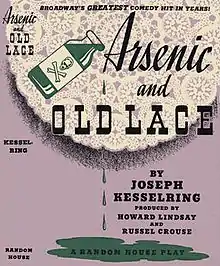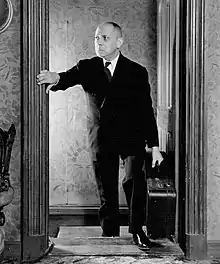Arsenic and Old Lace (play)
Arsenic and Old Lace is a play by American playwright Joseph Kesselring, written in 1939. It has become best known through the subsequent film adaptation starring Cary Grant and directed by Frank Capra.
| Arsenic and Old Lace | |
|---|---|
 First edition, 1941 | |
| Written by | Joseph Kesselring |
| Characters | Mortimer Brewster Martha Brewster Abby Brewster Teddy Brewster Jonathan Brewster The Rev. Dr. Harper Elaine Harper Dr. Einstein |
| Date premiered | January 10, 1941 |
| Place premiered | Fulton Theatre, Broadway |
| Original language | English |
| Genre | Dark comedy |
| Setting | The living room of the Brewster home in Brooklyn. The Present. |
The play was directed by Bretaigne Windust, and opened on Broadway at the Fulton Theatre on January 10, 1941. On September 25, 1943, the play moved to the Hudson Theatre, closing there on June 17, 1944, having played 1,444 performances.[1] The West End production - directed by Marcel Varnel and produced at London's Strand Theatre - enjoyed a similarly long run.[2] Opening on December 23, 1942 and closing on March 2, 1946, it totalled 1,337 performances.[3]
Of the 12 plays written by Kesselring, Arsenic and Old Lace was much the most successful. According to the opening night review in The New York Times, the play was "so funny that none of us will ever forget it."[4]
Plot

The play is a farcical black comedy revolving around the Brewster family, descended from the Mayflower settlers but now composed of maniacs, most of them homicidal. The hero, Mortimer Brewster, is a drama critic who must deal with his crazy, murderous family and local police in Brooklyn, New York, as he debates whether to go through with his recent promise to marry the woman he loves, Elaine Harper, who lives next door and is the daughter of the local minister.
His family includes two spinster aunts who have taken to murdering lonely old men by poisoning them with a glass of home-made elderberry wine laced with arsenic, strychnine, and "just a pinch" of cyanide; a brother who believes he is Theodore Roosevelt and digs locks for the Panama Canal in the cellar of the Brewster home (which then serve as graves for the aunts' victims; he thinks that they died of yellow fever); and a murderous brother who has received plastic surgery performed by an alcoholic accomplice, Dr. Einstein (a character based on real-life gangland surgeon Joseph Moran) to conceal his identity, and now looks like horror-film actor Boris Karloff (a self-referential joke, as the part was originally played on Broadway by Karloff).
The film adaptation follows the same basic plot, with a few minor changes.
The character Mortimer Brewster says of his family’s history that it is as if "...Strindberg wrote Hellzapoppin."
Cast

The opening night cast consisted of:
- Jean Adair as Martha Brewster
- John Alexander as Teddy Brewster
- Wyrley Birch as The Rev. Dr. Harper
- Helen Brooks as Elaine Harper
- Bruce Gordon as Officer Klein
- Henry Herbert as Mr. Gibbs
- Josephine Hull as Abby Brewster
- Allyn Joslyn as Mortimer Brewster
- Boris Karloff as Jonathan Brewster
- William Parke as Mr. Witherspoon
- John Quigg as Officer Brophy
- Anthony Ross as Officer O'Hara
- Edgar Stehli as Dr. Einstein
- Victor Sutherland as Lieutenant Rooney
Inspiration
When Kesselring taught at Bethel College in North Newton, Kansas, he lived in a boarding house called the Goerz House, and many of the features of its living room are reflected in the Brewster sisters' living room, where the action of the play is set. The Goerz House is now the home of the college president.
The "murderous old lady" plot line may also have been inspired by actual events that occurred in a house on Prospect St in Windsor, Connecticut, where a woman, Amy Archer-Gilligan, took in boarders, promising "lifetime care," and poisoned them for their pensions. M. William Phelps book The Devil's Rooming House (2010) tells the story of the police officers and reporters from the Hartford Courant who solved the case.[6] Kesselring originally conceived the play as a heavy drama, but it is widely believed that producers Howard Lindsay and Russel Crouse (who were also well known as play doctors) convinced Kesselring that it would be much more effective as a comedy. According to The Enyclopedia of American Humorists, Lindsay and Crouse gave the play its title by adapting the title of a Frank Sullivan humor collection called Broccoli and Old Lace.[7]
TV adaptation
On January 5, 1955, a 60-minute version of the play aired on the CBS Television series The Best of Broadway. It starred Boris Karloff, recreating his stage role as homicidal maniac Jonathan Brewster. Helen Hayes and Billie Burke played his not-so-innocent aunts, Abby and Martha. Peter Lorre and Edward Everett Horton repeated their roles as Dr. Einstein and Mr. Witherspoon, which they had played in Frank Capra's film version. John Alexander, who created the role of Teddy Brewster on Broadway and reprised it in the film version, returned once more to play the role in the broadcast. Orson Bean played the role of Mortimer Brewster.
Karloff played Jonathan once more (and for the last time) on the February 5, 1962 broadcast of NBC's Hallmark Hall of Fame. Dorothy Stickney and Mildred Natwick played Abby and Martha. Joseph Kesselring had sent his original play, then titled Bodies in Our Cellar, to Stickney when she was starring opposite her husband Howard Lindsay on Broadway in Life With Father (opened in 1939), with a view to her playing Abby Brewster. It would be 23 years before she would finally play the part. Tony Randall played Mortimer in the Hallmark production and Tom Bosley played Teddy.
In 1969, Robert Scheerer directed a TV version with Helen Hayes and Lillian Gish as the elderly aunts, Bob Crane as Mortimer, Fred Gwynne as Jonathan and David Wayne as Teddy.[8]
Revivals

Later revivals in the 1940s and 1950s had Bela Lugosi playing the role of Jonathan Brewster with box office returns reflecting better sales than when Boris Karloff traveled through the same cities.[9][10][11]
In 1966, Sybil Thorndike, Athene Seyler, Julia Lockwood and Richard Briers appeared in the play in London.[12] The play is still widely performed and has been translated into many languages, including a Russian film. A Broadway revival of the play ran from June 26, 1986, to January 3, 1987, at the 46th Street Theatre in New York, starring Polly Holliday, Jean Stapleton, Tony Roberts and Abe Vigoda.
Regional revivals
- It was revived again in 1998 with an Oklahoma-based production starring Betty Garrett, Carole Cook, and Michael Stever.
- A recent revival was mounted in February 2011 at the Dallas Theater Center starring Betty Buckley and Tovah Feldshuh.[13]
- A Hebrew version was staged at the Habima Theatre in Tel Aviv with the opening night on October 29, 2012, with Lea Koenig and Dvora Kaydar in the main roles.
- On November 19, 2016, Independent Theatre Pakistan opened their new season with a rendition of the performance at Ali Auditorium in Lahore, Pakistan.[14]
- The Maitland Repertory Theatre in Maitland, Australia,[15] put on a production of the play from October 9th to 27th 2019 by director Colin Delane.
References
- Arsenic and Old Lace at the Internet Broadway Database
- https://theatricalia.com/play/3h8/arsenic-and-old-lace/production/7rr
- 'Chit Chat', The Stage, 14 February 1946, p.4.
- "Arsenic and Old Lace", Brooks Atkinson, The New York Times, 11 January 1941.
- Erich von Stroheim at the Internet Broadway Database
- Leavenworth, Jessica (21 March 2010). "'Devil's Rooming House' Examines 'Arsenic And Old Lace' Killings (Interview)". Hartford Courant. Retrieved 20 April 2015.
- Gale, Steven H. (2016). The Enyclopedia of American Humorists. Routledge. p. 418. ISBN 9781315668826.
- Arsenic and Old Lace (1969) at IMDb
- Rhodes, Gary (2007). Bela Lugosi: Dreams and nightmares. Collectables Press. ISBN 978-0977379811.
- Kaffenberger, Bill; Rhodes, Gary (2012). No Traveler Returns: The lost years of Bela Lugosi. BearManor Media. ISBN 978-1593932855.
- Kaffenberger, Bill; Rhodes, Gary (2015). Bela Lugosi in Person. BearManor Media. ISBN 978-1593938055.
- https://theatricalia.com/play/3h8/arsenic-and-old-lace/production/znt
- Taitte, Lawson (February 11, 2011). "Buckley and Feldshuh shine in Arsenic and Old Lace". The Dallas Morning News.
- "'Arsenic & Old Lace: Play Highlights [LGS 15-C & ITP Collaboration]". Daily Pakistan. Retrieved 25 November 2016.
- "Maitland Repertory Theatre main page". Maitland, New South Wales, Australia.
Further reading
- Matthew C. Gunter (2012). The Capra Touch: A Study of the Director's Hollywood Classics and War Documentaries, 1934–1945. McFarland. pp. 49–51. ISBN 9780786488285.
- There's a Body in the Window-Seat: A History of Arsenic and Old Lace, America's Most Beloved Farce by playwright and author Charles Dennis is to be published by Asahina and Wallace in 2017.
External links
- Plot summary for Arsenic and Old Lace (1944 film), IMDb
- 1952 Best Plays radio adaptation at Internet Archive